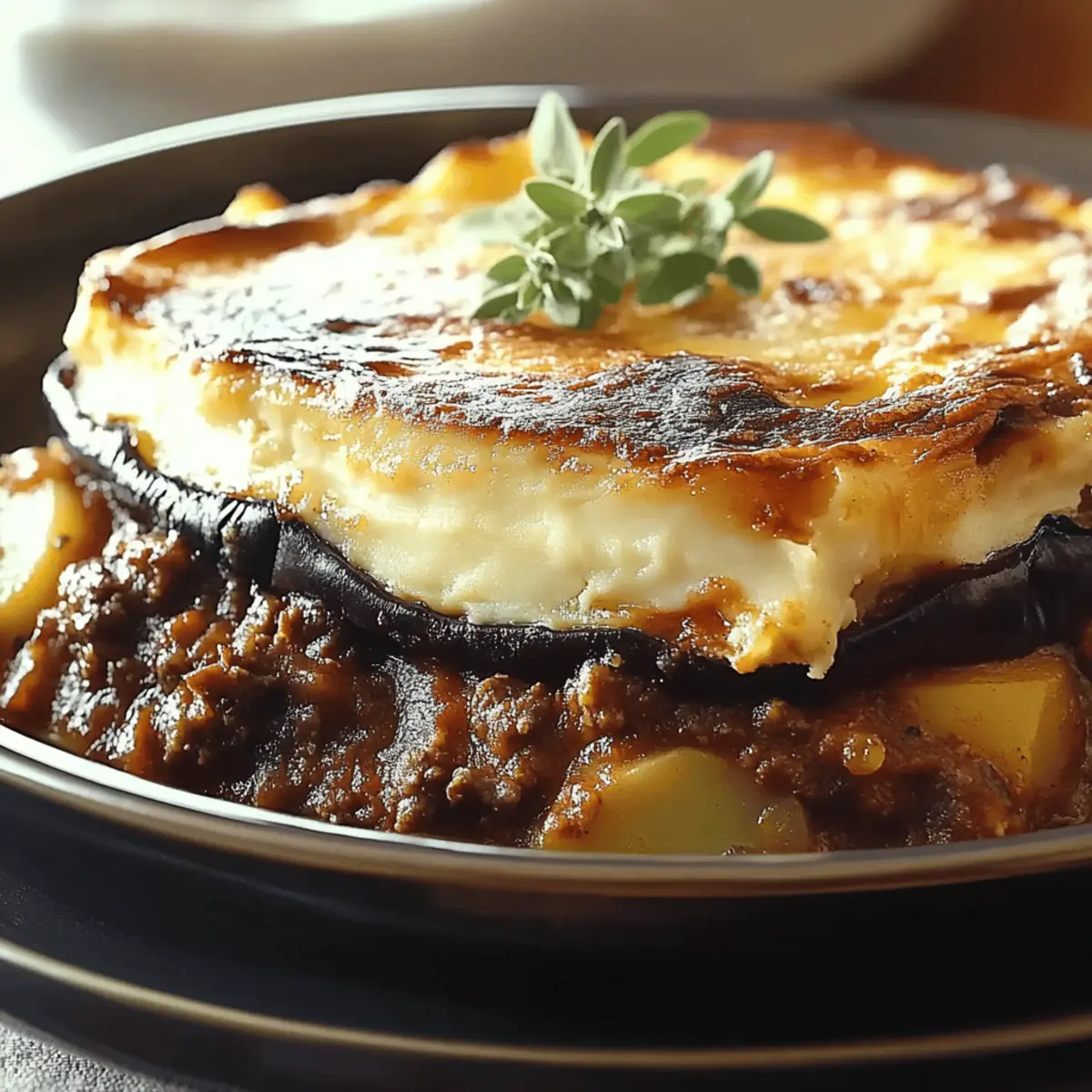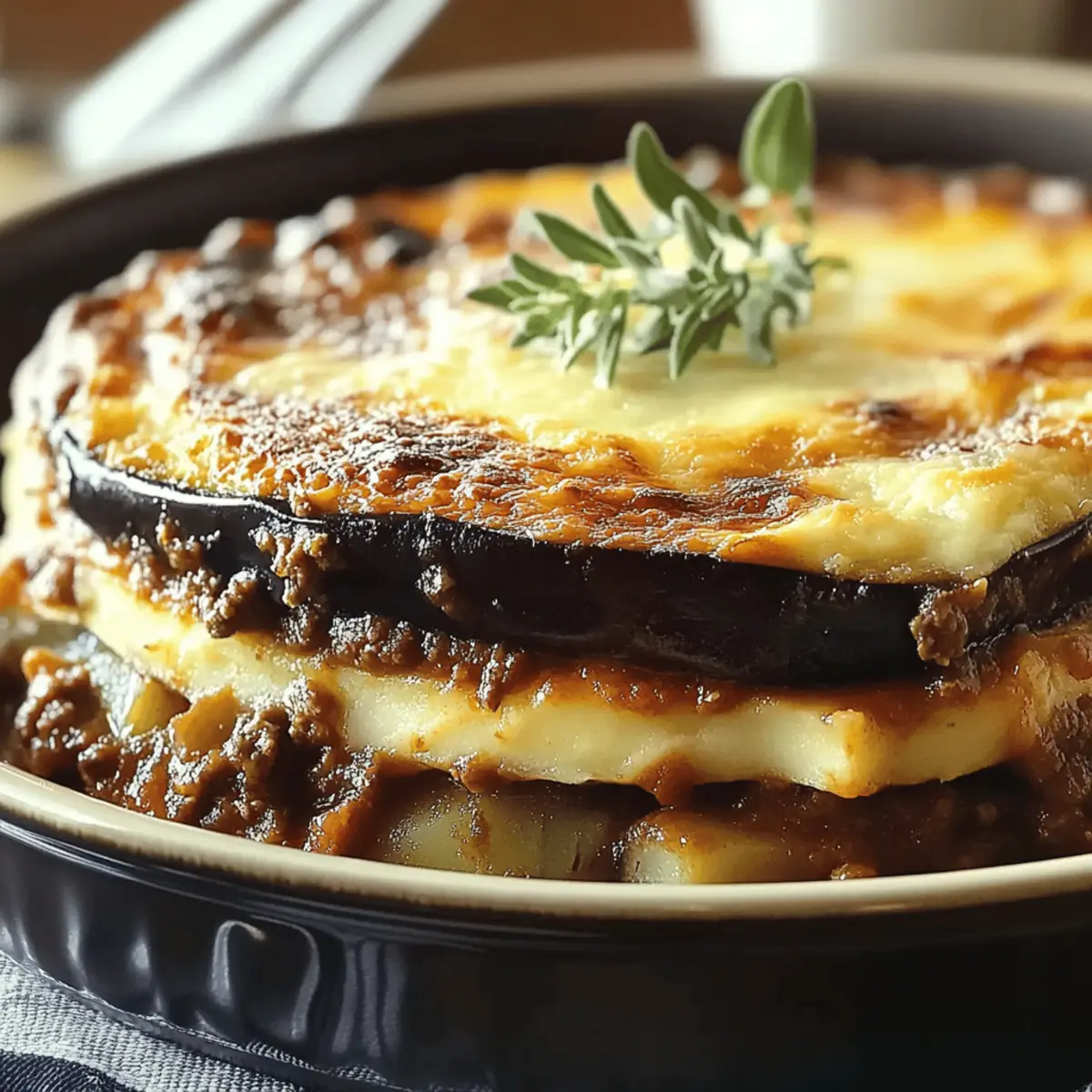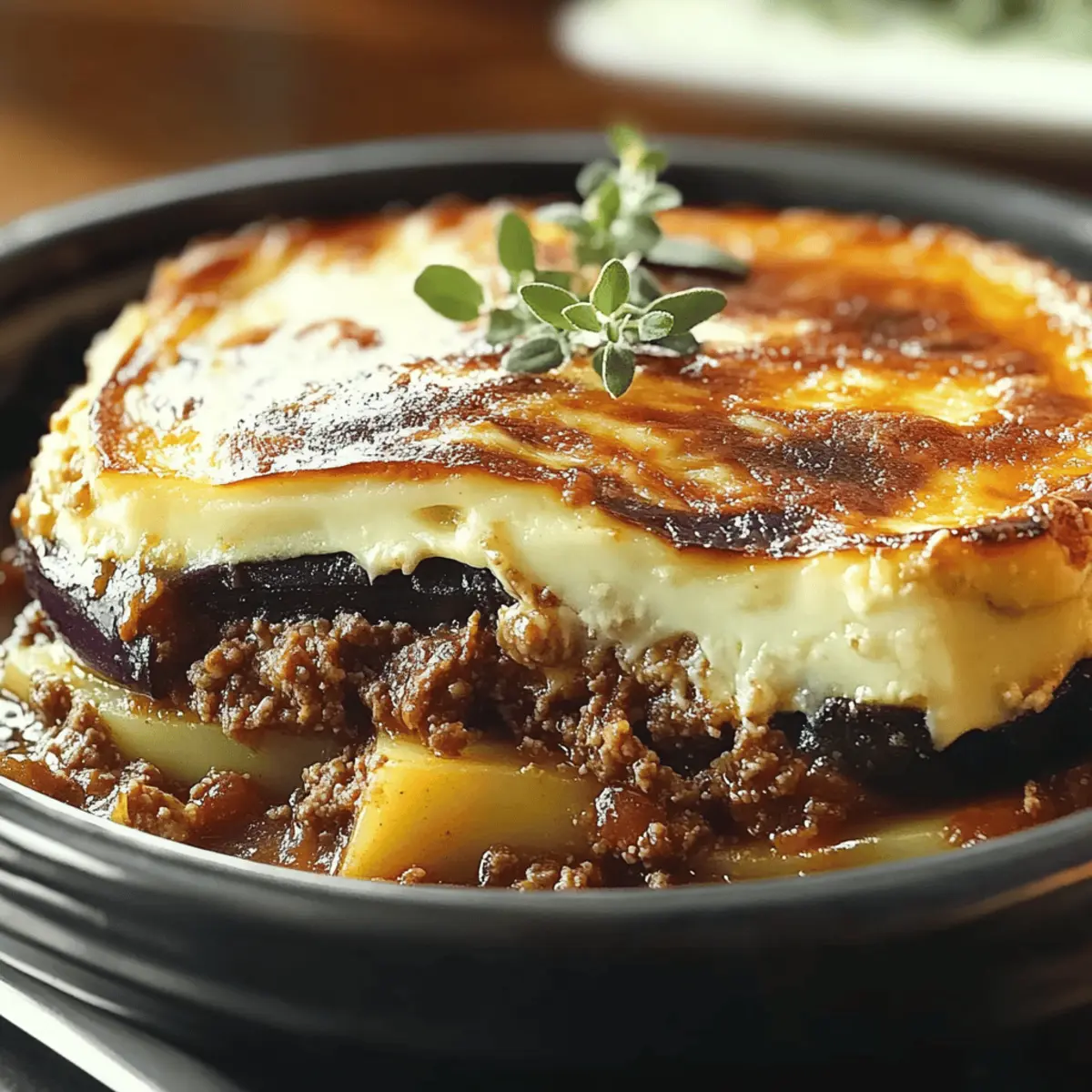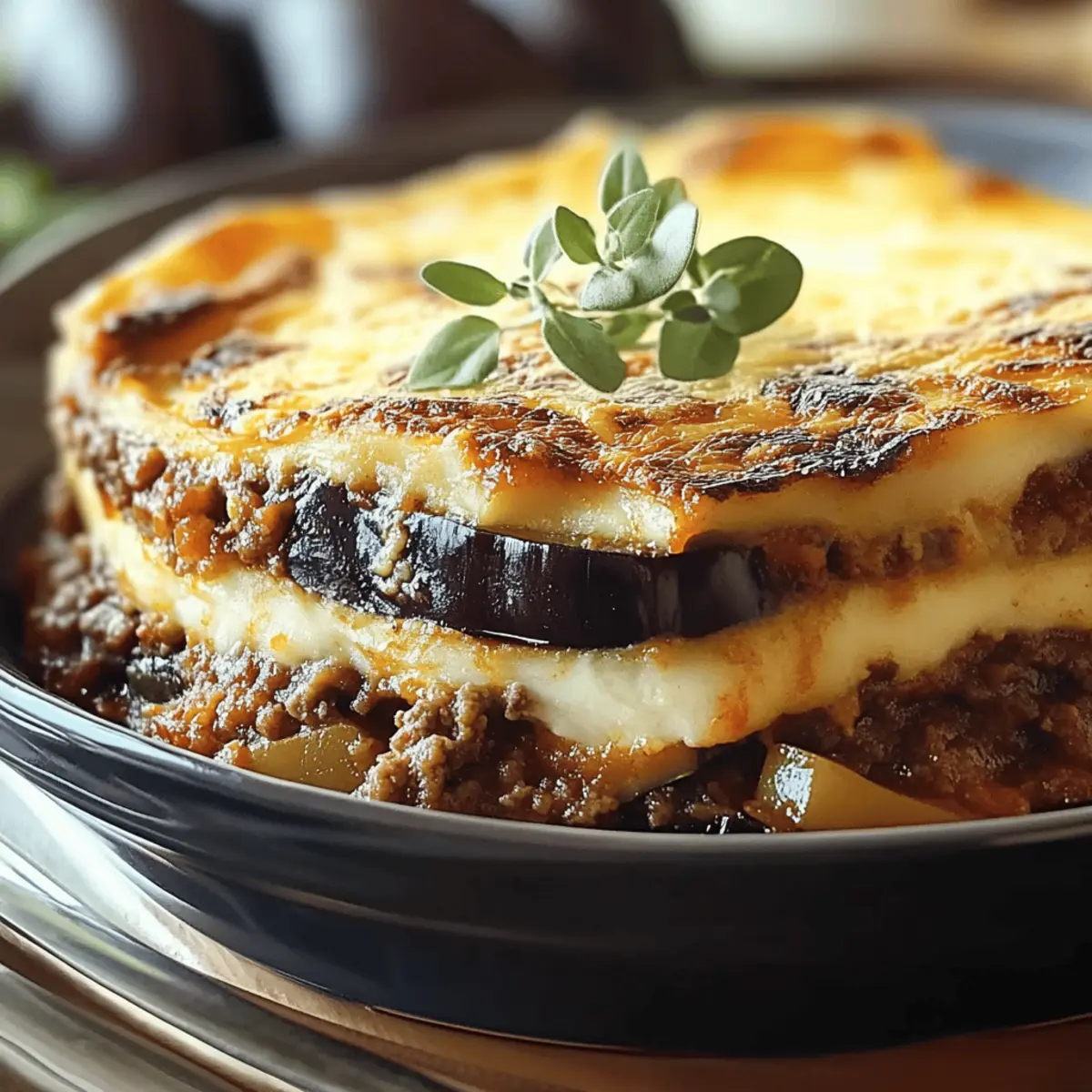The aroma of sizzling vegetables and savory spices dances through my kitchen as I whip up a dish that feels like a warm embrace—Outrageously Delicious Greek Moussaka. This beloved recipe layers tender eggplant, hearty ground meat, and a luscious béchamel sauce that truly makes it a standout meal. Not only is this moussaka a crowd-pleaser, but it also brings a taste of traditional Greek cuisine right to your home, offering comfort that transforms an ordinary dinner into something extraordinary. Plus, it’s incredibly versatile; you can easily switch up the meat or the cheese to suit your taste. Are you ready to dive into this Mediterranean classic? Let’s get cooking!

Why is Greek Moussaka So Special?
Layers of Flavor: Each layer in this dish brings a unique taste, from the savory meat to the creamy béchamel that melts in your mouth.
Versatility at Its Core: Easily swap out meats or cheeses, making this recipe adaptable for any dietary preference. Try it with lamb for authenticity or go for a lighter béchamel with ricotta!
Hearty and Filling: This recipe is perfect for family dinners, offering a comforting meal that’s sure to satisfy even the pickiest eaters.
Make-Ahead Marvel: Prepare it the night before for deeper flavors that will impress your guests. Serve alongside a refreshing Greek salad for the ultimate meal!
Cultural Connection: Embrace a taste of Greece right at home; it’s a delicious way to introduce your loved ones to traditional Mediterranean cuisine.
Once you try this Greek Moussaka, you’ll be enchanted by its delightful layers and incredible aromas. Get ready for an unforgettable meal!
Greek Moussaka Ingredients
For the Vegetable Layers
• Eggplants – Main vegetable that absorbs delicious flavors; choose firm ones.
• Potatoes – Provides a hearty base layer to support all the flavors.
• Zucchini – Adds a fresh, tender texture to complement other layers.
For the Meat Sauce
• Ground Meat (Beef or Lamb) – Core protein source; lamb offers an authentic taste, but beef is milder.
• Onion – Brings sweetness and balances the meat sauce; sweet red onion is ideal.
• Garlic – Fresh cloves enhance the flavor; use plenty for that aromatic kick.
• Crushed Tomatoes – Forms the sauce’s foundation; canned varieties work perfectly.
• Red Wine – Optional but recommended for a depth of flavor and acidity.
• Spices (Cinnamon, Nutmeg) – Key for the authentic warm profile central to Greek Moussaka.
• Herbs (Oregano, Thyme, Parsley) – Fresh herbs boost Mediterranean flavors; parsley adds a lovely garnish.
For the Béchamel Sauce
• Butter – Essential for a creamy béchamel base; don’t skip this!
• Gluten-Free Flour – Perfect for a gluten-free option in the béchamel sauce.
• Milk – Creates the creamy consistency necessary for a silky topping.
• Egg Yolks – Adds richness and binds the sauce; make sure they’re fresh.
• Nutmeg – Just a touch enhances the béchamel’s flavor profile beautifully.
For the Topping
• Kefalograviera Cheese – Traditional and deeply flavored; substitute with Parmesan or Pecorino if needed.
Step‑by‑Step Instructions for Greek Moussaka
Step 1: Prepare the Vegetables
Slice the eggplants, zucchini, and potatoes into ¼-inch rounds. Sprinkle salt over the eggplant slices and let them sit for 30 minutes to draw out excess moisture. This step enhances their flavor and texture, making them less soggy later. Rinse and pat dry before moving on to cooking.
Step 2: Fry the Vegetables
Heat a generous amount of olive oil in a skillet over medium heat. Fry the salted eggplant, zucchini, and potato slices in batches, ensuring they become golden on both sides—about 3-4 minutes per side. Once cooked, drain them on paper towels to absorb any excess oil, preparing for the layers of your Greek moussaka.
Step 3: Make the Meat Sauce
In a large pot, sauté the chopped red onion over medium heat until it turns translucent, around 5 minutes. Add the minced garlic, stirring for another minute until fragrant. Now, incorporate the ground meat, browning it thoroughly—approximately 6-8 minutes—before deglazing the pot with red wine, allowing it to simmer briefly while the alcohol evaporates.
Step 4: Simmer the Sauce
Pour in the crushed tomatoes along with your spices—cinnamon and nutmeg—then season with oregano and thyme. Let the meat sauce simmer for 10-15 minutes on low heat, stirring occasionally until it thickens. Just before removing from heat, mix in freshly chopped parsley and discard any bay leaves for a beautifully flavored moussaka.
Step 5: Prepare the Béchamel
In a saucepan, melt 4 tablespoons of butter over medium heat. Whisk in gluten-free flour and allow it to cook for about 2 minutes, stirring constantly to avoid browning. Gradually incorporate milk while whisking until the mixture thickens to a creamy consistency, around 5-7 minutes. Remove from heat to blend in egg yolks and a pinch of nutmeg, stirring until smooth.
Step 6: Assemble the Layers
Preheat your oven to 350°F (175°C). In a greased baking dish, layer the potato slices at the bottom, then add a layer of eggplant and zucchini. Sprinkle each layer with salt, pepper, and a generous portion of grated cheese in between. Repeat until all vegetable layers have been used, finishing with the delicious meat sauce on top.
Step 7: Add the Béchamel Sauce
Spread the creamy béchamel sauce evenly over the layered Greek moussaka, creating a smooth top that promises a delightful crust when baked. To finish, sprinkle more grated cheese over the béchamel for an extra touch of deliciousness that will melt and brown perfectly during baking.
Step 8: Bake to Perfection
Place the assembled moussaka in the preheated oven and bake for 40-45 minutes. Keep an eye on it, looking for a golden brown top as your cue for doneness. At the 30-minute mark, you may want to cover it with foil to prevent over-browning, ensuring a luscious finish for your Greek moussaka.
Step 9: Rest and Serve
Once the Greek moussaka is out of the oven, let it rest for at least 30 minutes before slicing. This resting period allows the flavors to settle and makes it easier to serve. The beautiful layers will hold together perfectly, providing a hearty and delicious meal for you and your loved ones.

Greek Moussaka Variations & Substitutions
Feel free to customize your Greek moussaka with these delightful variations that will brighten your dish!
-
Meat Swap: Use ground lamb instead of beef for an authentic flavor. The richness of lamb pairs beautifully with the robust spices!
-
Vegetarian Delight: Substitute the meat with lentils or chickpeas for a hearty vegetarian option. They absorb flavors and provide a satisfying texture.
-
Cheese Alternatives: Swap Kefalograviera for ricotta or a mix of mozzarella and Parmesan if you’re looking for a creamy, melty top. It adds a different flavor profile!
-
Gluten-Free Béchamel: Use gluten-free flour for the béchamel to keep it crowd-friendly. Just as creamy with no compromise on taste!
-
Spice It Up: Add a pinch of crushed red pepper or chili flakes to the meat sauce for a mild kick. Heat enhances the overall flavor experience!
-
Extra Veggies: Incorporate layers of spinach or mushrooms for added freshness and nutrition. They’ll absorb the saucy goodness beautifully!
-
Crunchy Topping: For an extra crispy layer, sprinkle breadcrumbs mixed with olive oil over the béchamel before baking. It adds delightful texture.
-
Herb Variations: Experiment with fresh basil or dill in the meat sauce for a unique twist on traditional flavors. Fresh herbs can brighten up the dish!
If you’re looking to serve this lovely moussaka with something refreshing, a classic Greek salad complements the rich flavors perfectly. Or, try it alongside a few warm, crusty pieces of bread. Enjoy making this dish truly your own!
What to Serve with Outrageously Delicious Greek Moussaka
To create a beautifully complete meal that sings with Mediterranean flavors, consider these delightful pairings.
-
Fresh Greek Salad: A refreshing blend of cucumbers, tomatoes, and olives; the acidity cuts through the richness of the moussaka beautifully.
-
Warm, Crusty Bread: Perfect for scooping up melty béchamel and saucy moussaka, each bite becomes a comforting indulgence.
-
Roasted Vegetables: Caramelized seasonal veggies like bell peppers and carrots offer sweetness and complementary textures alongside the savory moussaka.
-
Creamy Tzatziki Sauce: A cool yogurt dip with cucumber and garlic adds a refreshing contrast, balancing the warmth of the moussaka perfectly.
-
Lemon Rice Pilaf: Fluffy rice blended with fresh lemon zest brightens the palate and offers a lovely, aromatic side.
-
Herb-Infused Quinoa: Packed with protein and flavor, quinoa garnished with fresh herbs aligns wonderfully with the moussaka’s rich taste.
-
Sangria or Red Wine: A chilled glass of fruity sangria or a robust red wine enhances the dining experience, highlighting Mediterranean flavors.
-
Baklava for Dessert: Finish the meal on a sweet note! The flaky, nutty baklava is a heavenly contrast to the savory moussaka.
Make Ahead Options
These Outrageously Delicious Greek Moussaka are perfect for meal prep enthusiasts! You can assemble the entire dish up to 24 hours in advance—just cover it tightly with plastic wrap and refrigerate for deeper flavors before baking. To prep, layer the vegetables and meat sauce as directed, then top with béchamel. When you’re ready to serve, simply pop it in the oven, adding an extra 10-15 minutes to the baking time if chilled. For leftovers, store the moussaka in the fridge for up to three days. Reheat in the oven at 350°F (175°C) to maintain that delightful texture and cheesy goodness! Enjoy the convenience of having a homemade meal ready to go on busy nights!
Expert Tips for Greek Moussaka
-
Salt the Eggplant: Sprinkle salt on eggplant slices and let them sit for 30 minutes to reduce moisture and bitterness, ensuring your Greek moussaka doesn’t turn out soggy.
-
Consistent Stirring: Stir the béchamel sauce continuously while gradually adding milk to avoid lumps. If lumps form, strain the sauce before using.
-
Layer Carefully: Assemble your layers with seasoning and cheese in between to balance flavors and enhance the overall richness of your Greek moussaka.
-
Check Cheese Browning: Cover with foil for the first 30 minutes of baking to prevent over-browning of the cheese topping, achieving a perfect golden crust.
-
Rest Before Serving: Allow the moussaka to rest for at least 30 minutes once out of the oven. This helps the dish set for easier slicing and serving.
How to Store and Freeze Greek Moussaka
Fridge: Keep leftover Greek moussaka tightly covered in the refrigerator for up to 3 days. This allows the flavors to meld even more, making each bite deliciously rich!
Freezer: For longer storage, wrap slices of moussaka in plastic wrap, then aluminum foil, and freeze for up to 3 months. Remember to label the packages for easy identification!
Reheating: When ready to enjoy, thaw in the fridge overnight, then reheat in the oven at 350°F for about 20-25 minutes until heated through. This keeps the béchamel creamy and the layers intact.
Make-Ahead: You can assemble the Greek moussaka a day in advance and refrigerate before baking. This enhances the flavors and allows for a quick dinner option during the week!

Greek Moussaka Recipe FAQs
What kind of eggplant should I use for Greek moussaka?
Use firm eggplants that are free from dark spots and blemishes. I recommend slicing them and salting them for about 30 minutes to draw out excess moisture and bitterness, ensuring a perfect texture in your moussaka.
How long can I store leftover Greek moussaka in the fridge?
Leftover Greek moussaka can be stored tightly covered in the refrigerator for up to 3 days. This time allows the flavors to deepen, making every subsequent bite even more delightful!
Can I freeze Greek moussaka for later use?
Absolutely! Slice the cooled moussaka and wrap each piece tightly in plastic wrap, then in aluminum foil. You can freeze it for up to 3 months. Make sure to label the packages so you know what you’ve got when the craving hits!
What should I do if my béchamel sauce is lumpy?
If you find your béchamel sauce has lumps, don’t panic! Just pass it through a fine-mesh strainer into a clean saucepan. Then, gently reheat it while whisking to ensure a silky-smooth consistency before adding it to your moussaka.
Is there a gluten-free option for the béchamel sauce?
Yes! You can easily make a gluten-free béchamel by substituting regular flour with gluten-free flour. Just follow the same method, and you’ll have a creamy sauce that’s perfect for your Greek moussaka without the gluten.
Can I prepare Greek moussaka a day in advance?
Definitely! You can assemble the entire dish a day before and refrigerate it overnight before baking. This not only saves time but also enhances the flavors, giving you a warm, comforting meal with minimal effort when you’re ready to enjoy it!

Greek Moussaka That Will Warm Your Heart and Soul
Ingredients
Equipment
Method
- Slice the eggplants, zucchini, and potatoes into ¼-inch rounds. Sprinkle salt over the eggplant slices and let them sit for 30 minutes to draw out excess moisture. Rinse and pat dry before cooking.
- Heat olive oil in a skillet over medium heat. Fry the salted eggplant, zucchini, and potato slices in batches for about 3-4 minutes per side. Drain on paper towels.
- In a large pot, sauté the chopped red onion over medium heat until translucent, about 5 minutes. Add minced garlic, stirring for another minute. Incorporate ground meat, browning it for approximately 6-8 minutes, then deglaze with red wine and simmer briefly.
- Pour in crushed tomatoes along with cinnamon, nutmeg, oregano, and thyme. Let the sauce simmer for 10-15 minutes on low heat until it thickens. Stir in chopped parsley just before removing from heat.
- In a saucepan, melt butter over medium heat. Whisk in gluten-free flour and cook for about 2 minutes. Gradually add milk while whisking until thickened, around 5-7 minutes. Blend in egg yolks and nutmeg.
- Preheat your oven to 350°F (175°C). Layer potato slices at the bottom of a greased baking dish, followed by eggplant and zucchini. Season each layer with salt, pepper, and cheese. Finish with the meat sauce on top.
- Spread the béchamel sauce over the layered moussaka and sprinkle more cheese on top.
- Bake for 40-45 minutes until golden brown. Cover with foil at the 30-minute mark to prevent over-browning.
- Let the moussaka rest for at least 30 minutes before slicing for easier serving.

Leave a Reply